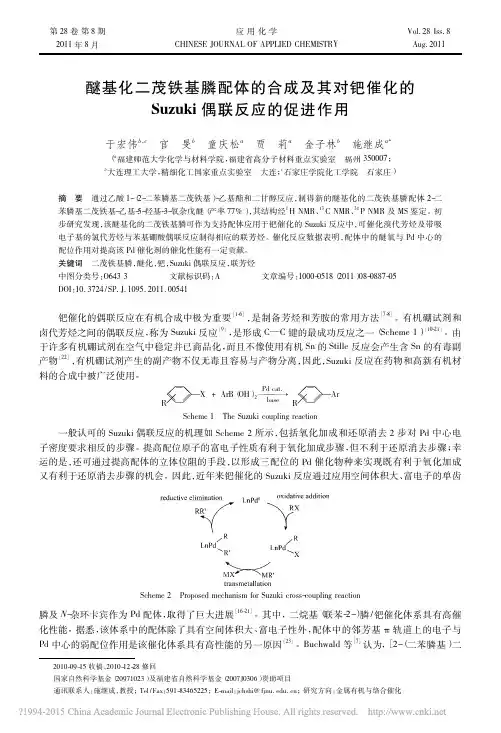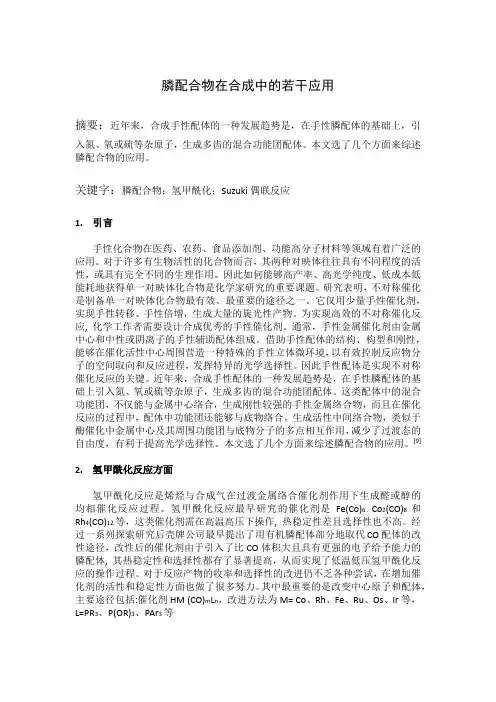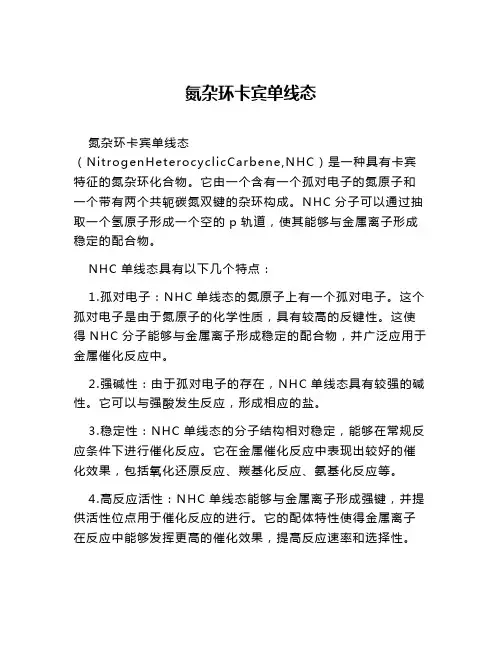N-杂环卡宾钯催化剂
- 格式:docx
- 大小:541.41 KB
- 文档页数:9



膦配合物在合成中的若干应用摘要:近年来,合成手性配体的一种发展趋势是,在手性膦配体的基础上,引入氮、氧或硫等杂原子,生成多齿的混合功能团配体。
本文选了几个方面来综述膦配合物的应用。
关键字:膦配合物;氢甲酰化;Suzuki偶联反应1.引言手性化合物在医药、农药、食品添加剂、功能高分子材料等领域有着广泛的应用。
对于许多有生物活性的化合物而言,其两种对映体往往具有不同程度的活性,或具有完全不同的生理作用。
因此如何能够高产率、高光学纯度、低成本低能耗地获得单一对映体化合物是化学家研究的重要课题。
研究表明,不对称催化是制备单一对映体化合物最有效、最重要的途径之一。
它仅用少量手性催化剂,实现手性转移、手性倍增,生成大量的旋光性产物。
为实现高效的不对称催化反应, 化学工作者需要设计合成优秀的手性催化剂。
通常,手性金属催化剂由金属中心和中性或阴离子的手性辅助配体组成。
借助手性配体的结构、构型和刚性,能够在催化活性中心周围营造一种特殊的手性立体微环境,以有效控制反应物分子的空间取向和反应进程,发挥特异的光学选择性。
因此手性配体是实现不对称催化反应的关键。
近年来,合成手性配体的一种发展趋势是,在手性膦配体的基础上引入氮、氧或硫等杂原子,生成多齿的混合功能团配体。
这类配体中的混合功能团,不仅能与金属中心络合,生成刚性较强的手性金属络合物,而且在催化反应的过程中,配体中功能团还能够与底物络合,生成活性中间络合物,类似于酶催化中金属中心及其周围功能团与底物分子的多点相互作用,减少了过渡态的自由度,有利于提高光学选择性。
本文选了几个方面来综述膦配合物的应用。
[9]2.氢甲酰化反应方面氢甲酰化反应是烯烃与合成气在过渡金属络合催化剂作用下生成醛或醇的均相催化反应过程。
氢甲酰化反应最早研究的催化剂是Fe(Co)6、Co2(CO)8和Rh4(CO)12等,这类催化剂需在高温高压下操作, 热稳定性差且选择性也不高。
经过一系列探索研究后壳牌公司最早提出了用有机膦配体部分地取代CO配体的改性途径,改性后的催化剂由于引入了比CO体积大且具有更强的电子给予能力的膦配体, 其热稳定性和选择性都有了显著提高,从而实现了低温低压氢甲酰化反应的操作过程。

河北大学硕士学位论文卡宾衍生物及其环加成反应的研究姓名:***申请学位级别:硕士专业:有机化学指导教师:李小六;胡文浩2011-05摘要有机合成化学是合成复杂有机分子的基础,新反应类型、新的反应中间体、以及经典反应在合成中的应用等研究一直是化学领域的热点。
近年来,卡宾参与的环加成反应、氮宾的插入反应、氮杂环卡宾催化剂的合成,以及金属催化的C-C偶联反应的应用得到了广泛发展。
卡宾(carbene)又称碳宾、碳烯,是亚甲基-CH2及其取代衍生物的总称。
卡宾作为重要的中性活泼中间体,在有机合成中得到广泛的应用。
主要用于增长碳链、制备小环烷烃、制取多环化合物。
过渡金属催化的C-C偶联以反应条件温和,产率高等特点在有机合成领域得到了广泛应用。
基于此,我们研究了卡宾、氮宾参与的1,3-偶极环加成反应,合成了金鸡纳碱NHC 类催化剂,噻唑硫脲类,咪唑硫脲类催化剂;过渡金属催化下硝基甲苯与碘代苯的C-C 偶联反应,优化了反应条件,合成了2-氨基二苯甲酮。
具体研究内容如下:第一部分:以α-重氮羰基化合物与氨基醇为起始原料,制备重氮亚胺类化合物。
通过系统研究提出了可能胺解的反应机理。
并且将氮杂环卡宾作为配体开发了新型金鸡纳碱NHC类催化剂,噻唑硫脲类和咪唑硫脲类催化剂,研究了催化剂在醛的安息香缩合反应中的应用。
第二部分:研究了过渡金属催化下硝基甲苯和碘代苯的C-C偶联反应制备了2-氨基二苯甲酮。
意外发现发生偶联反应的同时还发生了氧化还原反应。
关键词卡宾氮宾氮杂环卡宾偶联反应IAbstractOrganic synthesis is the basis for synthesis of complex organic molecules, The p-urpose of this passage is to cast some light on new reaction types, new synthetic inte rmediates, and the classic reaction to inspire organic chemists to pay more attention t-o this hot field. In recent years, carbene cycloaddition reaction, insertion by nitrene, N-heterocyclic carbene catalysts, and transition metal catalysis C-C coupling reaction h as been widely applied development.Carbene is methylene and its substituted derivatives in general. Carbene as a neut -ral active intermediates in organic synthesis has been used widely. Mainly used for g -rowing carbon chain, prepared a small ring hydrocarbons, extraction of polycyclic co-mpounds.Transition metal-catalyzed C-C coupling reactions with mild conditions, high yield characteristics in the field of organic synthesis have been applied rapidly.Based on this, we studied the carbene and nitrene participate in the 1,3 - dipolar cycloaddition reaction. We synthesized cinchona alkaloids, thiazole thiourea, imidazole thiourea catalyst; Transition metal-catalysis of nitrobenzene with iosobenzene C-C cou -pling reactions, optimum of reaction conditions, synthesis of 2-aminobenzophenone.Part I: With α-diazo carbonyl compound and amino alcohols as starting material. Prepared diazo imine compounds and study of reaction mechanism. We have synthesiz ed a new class of NHC cinchona catalyst, thiazole thiourea and imidazole thiourea cat -alyst. in the benzoin condensation reaction of aldehydes in the application.Part II: The second part focuses on transition metal catalysis of o-nitrobenzene w -ith iodobenzene C-C coupling reactions. We are surprised to find that the coupling re -action occurred and redox reactions. Synthesis of 2-aminobenzophenone.Keywords carbene nitrene N-heterocyclic carbene cross-coupling reactionⅡ绪论绪论卡宾是非常活泼的活性中间体,具有很多独特的反应性。


氮杂环卡宾单线态
氮杂环卡宾单线态(NitrogenHeterocyclicCarbene,NHC)是一种具有卡宾特征的氮杂环化合物。
它由一个含有一个孤对电子的氮原子和一个带有两个共轭碳氮双键的杂环构成。
NHC分子可以通过抽取一个氢原子形成一个空的p轨道,使其能够与金属离子形成稳定的配合物。
NHC单线态具有以下几个特点:
1.孤对电子:NHC单线态的氮原子上有一个孤对电子。
这个孤对电子是由于氮原子的化学性质,具有较高的反键性。
这使得NHC分子能够与金属离子形成稳定的配合物,并广泛应用于金属催化反应中。
2.强碱性:由于孤对电子的存在,NHC单线态具有较强的碱性。
它可以与强酸发生反应,形成相应的盐。
3.稳定性:NHC单线态的分子结构相对稳定,能够在常规反应条件下进行催化反应。
它在金属催化反应中表现出较好的催化效果,包括氧化还原反应、羰基化反应、氨基化反应等。
4.高反应活性:NHC单线态能够与金属离子形成强键,并提供活性位点用于催化反应的进行。
它的配体特性使得金属离子在反应中能够发挥更高的催化效果,提高反应速率和选择性。
总结来说,氮杂环卡宾单线态是一种具有孤对电子和碱性的
化合物,具有较好的稳定性和较高的反应活性。
它在金属催化
反应中发挥重要的作用,并在有机合成中具有广泛的应用潜力。
2010年,Michael G. Gardiner 和他的同事合成了新型的氮杂环卡宾化合物,A colorless solution of 1 over anhydrous Na2CO3 in dry MeOH was heated at 508C for two hours to give a red solution, from which red crystals of 2 were obtained in 84%yield after filtration and concentration (Scheme 1).[8] Complex 2 has high stability as a solid (more than one year) and in MeOH and THF (several months). The complex is tolerant to moisture, but reacts quickly with atmospheric oxygen in solution and the solid state.Peter D. W. Boyd, Alison J. Edwards, Michael G. Gardiner, Angew. Chem. Int. Ed. 2010, 49, 6315 –6318.2008年,Takeshi Makino和他的同事得到了具有二齿氮杂环配体的钯配合物,The bidentate NHC-palladium complexes 4a–e were prepared by the reaction of 1-(4-iodoaryl)-3-aryl-4,5-dihydroimidazolinium salt (1)[16] and xanthenediboronic acid (2)[17] in the presence of Pd(PPh3)4 and Ag2O followed by palladation[18] (Scheme 1). The bis(imidazolidene) derivative 6 was also synthesized in a similar way (Scheme 2).Takeshi Makino, Hyuma Masu, Kosuke Katagiri, Ryu Yamasaki, Isao Azumaya,and Shinichi Saito,Eur. J. Inorg. Chem. 2008, 4861–4865.There are many examples of monodentate NHCs, but only a few examples of alkane-bridged chelating biscarbene ligands. Chelated carbenes are expected to be more stable since one possible decomposition pathway, reductive elimination of the carbene, should be slower for this conformationally restricted case. A chelating coordination is one way to obtain highly stable catalysts capable of tolerating harsher reaction conditions than traditional phosphine catalysts. Sebastian Ahrens 和他的同事化合物长链烷烃桥联配体的钯配合物,Sebastian Ahrens, Alexander Zeller, Maria Taige, and Thomas Strassner Organometallics, Vol. 25, No. 22, 2006N-Heterocyclic carbenes (NHCs), first prepared independently by Wanzlick and Schnherr[1] and fele[2] in 1968, attracted little interest from the chemical community until 1991, when Arduengo et al. revealed the first stable, crystalline NHC(1, IAd).[3] The potential of this class of compounds to serve as spectator ligands in transition-metal complexes was recognized in 1995 by Herrmann et al.[4] Soon thereafter, the exploitation of the remarkable potential of NHC ligands in catalysis began. The above seminal works led to the development of a variety of other NHC platforms (see right column)[5] and their transition-metal complexes for catalytic applications. However, only NHCs derived from imidazolium or 4,5-dihydroimidazolium salts have found wide-spread use in homogeneous catalysis to date. The most important example is the ruthenium metathesis catalyst developedby Grubbs and co-workers, for which the Nobel Prize was awarded. Replacement of one of the two tricyclohexyl phosphane ligands in the generation I Grubbs catalyst with the bulky carbene SIMes (3) led to significant improvements in terms of catalyst stability, activity, and substrate range in subsequent generations.[6] Palladium is another transition metal capable of directing a wide range of useful transformations,[7] in particular C-C and C-heteroatom cross-coupling and carbopalladation reactions.[8] The use of bulky carbenes, in particular IPr (4) and SIPr (5), as ligands in these transformations has also resulted in significant improvements in catalyst performance compared to the more traditional phosphane ligands.[1] H.-W. Wanzlick, H.-J. Schnherr, Angew. Chem. 1968, 80, 154; Angew. Chem. Int. Ed. Engl. 1968, 7, 141– 142.[2] K. fele, J. Organomet. Chem. 1968, 12, P42– P43.[3] A. J. Arduengo III, R. L. Harlow, M. Kline, J. Am. Chem. Soc.1991, 113, 361– 363.[4] W. A. Herrmann, M. Elison, J. Fischer, C. Kchter, G. R. J. Arthus, Angew. Chem. 1995, 107, 2602– 2605; Angew. Chem. Int. Ed. Engl. 1995, 34, 2371– 2373.[5] F. E. Hahn, Angew. Chem. 2006, 118, 1374–1378; Angew. Chem. Int. Ed. 2006, 45, 1348–1352.[6] M. Scholl, S. Ding, C.-W. Lee, R. H. Grubbs, Org. Lett. 1999, 1,953–956.[7] Handbook of Organopalladium Chemistryfor Organic Synthesis (Ed.: E. Negishi), Wiley, New York, 2002.[8] Metal-catalyzed cross-coupling reactions, 2nd ed. (Eds.: A.de Meijere, F. Diederich), Wiley, New York, 2004.In terms of catalysis, the activity of these complexes has been scarcely examined, that is, only in the Heck, the Suzuki-Miyaura, and the Buchwald-Hartwig reactions. Compound 1 was found to catalyze the coupling of 4-bromoacetophenone and butyl acrylate at low catalyst loadings but was only studied for limited examples.22 On the other hand, 6 showed only poor activity in the Heck reaction, probably because of the lack of steric pressure from the thiazolydene ligand.17b In 2004, Glorius reported the outstanding activity of 2 and 3 in the Suzuki-Miyaura reaction.16c These complexes, possessing an NHC of the IBiox family, allowed for the formation of a tetra-ortho-substituted biphenyl in high yield. Tested as well in the Suzuki-Miyaura coupling, complex 7 was found to be efficient for the coupling of aryl bromidesand chlorides in water,16e while 8 coupled only bromides but with a larger scope, involving unactivated and sterically hindered substrates.16dIn 2002, we studied the activity of 5 in the N-aryl amination reaction.20 This complex was found to be highly efficient for the coupling of aryl bromides and chlorides. A variety of amines could be coupled with activated, unactivated, encumbered, and heteroaromatic halides in high yields and in short reaction times (Scheme 2). Interestingly, due to the robustness of 5, reactions could be carried out on the benchtop under aerobic conditions without loss of activity. Recently 5 has been shown as excellent precatalysts in the Suzuki-Miyaura reaction.20b22 McGuinness, D. S.; Cavell, K. J. Donor-Functionalized Heterocyclic Carbene Complexes of Palladium(II): Efficient Catalysts for C-C Coupling Reactions. Organometallics 2000, 19, 741–748.17(b) Yen,S. W.; Koh, L. L.; Hahn, F. E.; Huynh, H. V.; Hor, T. S. A. Convenient Entry to Mono- and Dinuclear Palladium(II) Benzothiazolin-2-ylidene Complexes and Their Activities Toward Heck Coupling. Organometallics 2006, 25, 5105–511216(c) Altenhoff, G.; Goddard, G.; Lehmann, C. W.;Glorius, F. Sterically Demanding Bioxazoline-Derived N-Heterocyclic Carbene Ligands with Restricted Flexibility for Catalysis. J. Am. Chem. Soc. 2004, 126,15195–15201.(d) Shi, M.; Qian, H.-X. A Stable Dimeric Mono-Coordinated NHCPd(II) Complex: Synthesis, Characterization, and Reactivity in Suzuki-Miyaura CrossCoupling Reaction. Appl. Organometal. Chem. 2005, 19, 1083–1089.(e) Huynh, H. V.; Han, Y.; Ho, J. H. H.; Tan, G. K. Palladium(II) Complexes of Sterically Bulky, Organometallics 2006, 25,3267–3274.20(b) Diebolt, O.; Braunstein, P.; Nolan, S. P.; Cazin, C. S. J. Room temperature activation of arylchlorides in Suzuki-Miyaura coupling using a [PdCl2(NHC)]2 complex (NHC ) N-heterocyclic carbene). Chem. Commun., 2008,3190–3192.Typically, NHC-containing palladacycles are synthesized in high yields by addition of a nucleophilic carbene to an acetate- or halogen-bridged palladacycle dimer. In 2003, Iyer described the synthesis and applications of palladacyles 9-11.25 These precatalysts were tested in the Heck reaction where they displayed good to high activity. With aryl bromides, TONs between 40 000 and 90 000 were observed, whereas the use of chlorides was less successful. The activity of compound 10 was further studied in the Suzuki-Miyaura reaction where, as observed in the Heck, aryl bromides were easily coupled and aryl chlorides were found to be more reluctant partners. A large series of NHC-containing phosphapalladacycles, including 12-15, was reported by Herrmann.26 Their catalytic activity in the Heck reaction was investigated,showing promising results for further improvement. Notably, the use of 15 allowed for the coupling of aryl chlorides without the need for additives. Bedford and co-workers reported the formation of phosphite palladacycles 16-19 and studied their activity in the Suzuki-Miyaura reaction.27 Overall, these catalysts performed quite poorly (17 being the most efficient) and could only couple unhindered and activated aryl bromides.2825 Iyer, S.; Jayanthi, A. Saturated N-Heterocyclic Carbene Oxime and Amine Palladacycle Catalysis of the Mizoroki-Heck and the Suzuki Reactions. Synlett 2003, 1125–1128.26 Frey, G. D.; Schu ¨ tz, J.; Herdtweck, E.; Herrmann, W. A. Synthesis and Characterization of N-Heterocyclic Carbene Phospha-Palladacycles and Their Properties in Heck Catalysis. Organometallics 2005, 24, 4416–4426.27 Bedford, R. B.; Betham, M.; Coles, S. J.; Frost, R. M.; Hursthouse, M. B. An Evaluation of Phosphine and Carbene Adducts of Phosphite- and Phosphinite-Based Palladacycles in the Coupling of Alkyl Bromides With Aryl Boronic Acids. Tetrahedron 2005, 61, 9663–9669.28 Bedford, R. B.; Betham, M.; Blake, M. E.; Frost, R. M.; Horton, P. N.; Hursthouse, M. B.; Lo ´ pez-Nicola ´ s, R.-M. N-Heterocyclic Carbene Adducts of Orthopalladated Triarylphopshite Complexes. Dalton Trans. 2005, 2774–2779.在近期的研究中,钯基催化剂被大量的应用于有机合成反应体系,并且发挥了巨大的作用.钯基催化剂的最主要优势是在形成C-C键,C-O键,C-N键,甚至 C-S键的同时,不会影响反应物的其他官能团,并且反应条件温和$这样的催化过程不仅符合绿色环保的主题,又经济高效,在生态环境保护愈来愈重要的今天,钯基催化剂因为不会产生严重的环境污染问题,所以在工业上具有较高的经济价值[1]1.1钯催化偶联反应相对于传统的均相催化体系,钯催化体系应用于偶联反应可以解决催化剂重复使用性差,反应产物分离困难等问题.其中最具有代表性的就是是heck反应和suzuki反应[2]这两类反应在有机反应中对于构建碳碳键十分重要,自被发现以来,它们已经被广泛地应用于医药合成,新型材料合成以及天然产物的合成中.heck和 Mirozoki 最早于20世纪中后期发现了heck反应,并且由 heck通过的深入的研究逐渐发展起来.heck 反应的主要过程是在钯的催化下,使活化的不饱和烃和卤代烃发生反应,生成的主要产物为反式取代物,反应中较常使用的是芳基卤代烃,反应的常用温度在20-180o C[3].最初,heck 反应并没有得到化学研究者们足够的重视,但是随着化学工业的发展,heck 反应可以通过一步反应就得到碳碳键的特点更符合现代工业高效%环境友好的要求,因此近年来引起了一股研究热潮.Dr.Herrmann等[4]发明了最早的环钯催化剂,并将应用于heck 反应中,反应15h,可以达到90%的转化率,同时该催化剂对含有吸电子基团的氯代苯也有很好的活性。